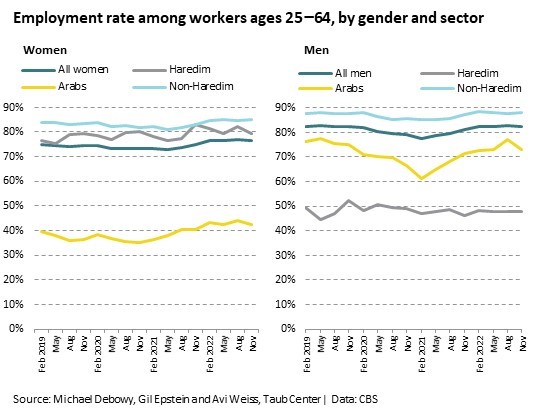Executive Summary
Taub Center researchers Michael Debowy, Prof. Gil S. Epstein, and Prof. Avi Weiss looked at the Israeli labor market following the shocks it experienced during the COVID-19 pandemic. The research surveys the trends in employment and wages in the various sectors of the economy and among the various segments of the population, the investment in workers’ human capital as revealed by the state of higher education and vocational training, and forecasts for Israel’s labor market. The study findings show that the labor market recovered surprisingly well from the COVID pandemic, although to ensure long-term growth, there must be continued investment in making higher education accessible, as well as vocational training, investment in infrastructure, and those factors that influence overall productivity and possibilities for quality employment for Israeli workers.
Unemployment, employment and wages
In 2022, the unemployment rate fell dramatically — to less than 3.5% in the spring, one of the lowest rates in the history of the Israeli labor market. It then rose somewhat at the end of the summer (reaching 4.3% in October). Even if workers who were on furlough from their work due to the pandemic are included among the unemployed, the unemployment rate during the first half of the year fell to less than its 2019 level and during the second half of the year it did not exceed the level at the end of 2019 by more than half a percentage point.
In 2020–2021, there was a significant decline in employment relative to 2019 across almost all the industries; however, in 2022 it returned to its previous level in most industries. In some industries, the number of jobs increased significantly relative to the pre-pandemic level. Particularly noticeable are the health, social welfare, and nursing care industry (112,000 more jobs than in 2019) as well as the high tech sector (60,000 more jobs). The construction industry — which was severely impacted by the pandemic — also experienced a recovery and an increase of about 17,800 jobs, which supported, among other things, a recovery in employment among Arab men. However, some industries remained smaller than they were in 2019 with respect to level of employment. The most prominent is management and support services (33,000 fewer jobs than in 2019) and accommodation and food services (12,100 fewer jobs).
The extent of recovery varied across segments of the population. A comparison by gender shows that while the rate of employment among men in the summer of 2022 was equal to that in the summer of 2019 (82%), among women, there was an increase of about 2 percentage points (77% vs 75%). Similarly, the rate of employment among women in general returned to its former level and even surpassed it. There was also an impressive recovery among Arab men. In contrast, the rate of employment remained lower than prior to the pandemic for Haredi (ultra-Orthodox) men.
 Employment and wages across industries, including Israeli high tech
Employment and wages across industries, including Israeli high tech
In traditional manufacturing and construction, wages rose by 9%–11% between 2019 and 2022. In the information and communication industry and in the high tech sector, they rose by 18%–19%; in agriculture and in finance and insurance, they rose by 9%; and in the mining and quarrying industry, they rose by 13%.
There was a drop in the average wage of about 9% in the health and social welfare industry, in which the number of jobs surged during the pandemic. This was apparently because most of the jobs that were added paid less than the industry average (like workers employed in COVID-testing).
In the high tech sector, which employs about 10% of the workers in the economy, not only did the number of employees increase during the pandemic and the recovery, but there was a surprising increase in wages (which were high from the start). The research shows that while wages outside of high tech grew by 4% following the pandemic, the average wage in the economy as a whole grew by about 7%, which implies that the wage increases in high tech were responsible for a large proportion of the increase in the average wage. The research also found that during most of the last decade, wage increases in high tech consistently led to wage increases in the rest of the economy. This finding supports the hypothesis that other industries are forced to raise wages in order to compete with high tech and to prevent the “flight” of their workers. Although there has recently been a lot of discussion of layoffs in high tech, so far there are no signs of a drop in the number of employees in the sector, as, apparently, in parallel to companies that are firing, there are also companies that are hiring.
Students in higher education
This paper helps solve the mystery of the unusually large number of new students in higher education during the first year of the pandemic. In the 2020/2021 academic year, there was a sharp rise in the number of higher education students, which was caused essentially by the restrictions and lack of alternatives available to young adults that prevented them from traveling or working. What was not clear at the time was whether this was simply a temporal shift, with the increase reflecting young people who would have chosen to obtain a higher education in any case, but chose to start their education earlier because they had few alternatives during the shutdown, or indicated many who would not have chosen to get a higher education at all, but did so because of the lack of viable options. The data on the number of new students in the 2021/2022 academic year help us conclude that the latter is most probably the case — the growth seems to have come from young adults who would not have studied at all were it not for the pandemic.




